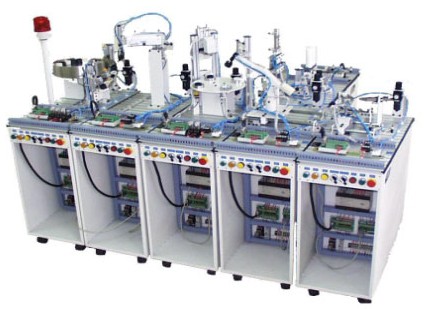The integration of industrial electrical control and logistics management system for experimental equipment is my company manipulative ability to improve students practice skills and the design, production of a practical laboratory equipment. Seven of the device by the respective independent and closely linked to the workstation component. The seven points are: Feeding detection stations, handling stations, processing station, the installation station, the installation handling stations, classification stations (Intelligent Warehouse) and Fieldbus.
The experimental apparatus of a major distinguishing feature is: has good flexibility, which means each station has a PLC control system of independent control. Training will be seven separate modules can accommodate more students at the same time learning. The basic unit after the completion of the training module, can also be adjacent two points, three points ... linked up 7.30 points, the study of complex systems control, programming, assembling and debugging technology.
As the system include electromechanical integration professionals involved in the study, such as motor drives, pneumatic, PLC (programmable logic controller), sensors and other technology to provide students with a typical integrated technology environment that enables students many have studied here Billing Division of expertise full understanding, comprehensive training and mutual upgrade. So this package is suitable for installation on in-school students and early posts on the engineering and technical personnel training, is to nurture the ideal talent mechatronics equipment.
Second, through the system can learn:
L, on the working principle of material hopper
2, the use of various sensors
3, learning methods
4, and the use of pneumatic components adjustment
5, technical skills
During the experiment, the system can also through the training and development of students as follows capacity; team spirit, a spirit of cooperation and organizational capacity.
Training courses and forms can be carried out as follows:

Third, the system structure
The system is installed in the various stations grooved aluminum plate, all the stations can be easily linked to automatic processing of a production line.
3.1 all the stations on
Feeding stations Detection
-- Return on the workpiece material and Taiwan will work in order to detect
-- Upgrade and installation will upgrade the workpiece detection workpiece color
Handling Station
Workpieces on the station will be moved to its next stop from
Processing Station
-- Workpiece using rotary table will be among the four-position switch
-- Borehole drilling unit
-- Detection of drilling depth
Installation Station
-- Choose to install the hopper workpiece
-- Will be launched in the workpiece from the hopper
-- Will be installed in place workpiece
Installation handling station
-- On the station will be the installation of the workpiece pick up the Add -
-- Will be installed to lay down their stations pick up the workpiece
Classification Station (Intelligent Warehouse)
-- Classified by the type workpiece
-- Will be pushed depositing the workpiece
Fieldbus
3.2 system components
Mechanical parts:
. Hopper
2. Turret
3. Workpiece slipway
4. Upgrade installations
5. Count capacitance switches
6. Color of the workpiece and the photoelectric switch
Control components:
1. PLC (a)
2. Switching Power: 220V / 24V / 5V (with short-circuit protection)
3. Control Panel: eight buttons
4. Two sets of I / O Interface Board
5. A set of I / O communications interface board
6. 24V gear motor
7. A group of electric control valve device and its implementation
3.2.2. Handling station
Mechanical parts:
1. Manipulator
2. Arm
3. Turret
4. Inductive sensor
Control components:
1. PLC (a)
2. Switching Power: 220V / 24V / 5V
(With short-circuit protection)
3. Control Panel: eight buttons
4. Two sets of I / O Interface Board
5. A set of I / O communications interface board
6. Four electric control valve device and its implementation
Mechanical parts:
1. Rotary table
2. Drilling motor components
3. Detection cylinder components
4. Workpiece detection sensors in place and Turntable
Control components:
1. PLC (a)
2. Switching Power: 220V / 24V / 5V (with short-circuit protection)
3. Control Panel: eight buttons
4. Two sets of I / O Interface Board
5. A set of I / O communications interface board
6. 24V gear motor
7. Electric control valve three groups and the implementation of devices
Mechanical parts:
1. Sucker Manipulator
2. Upper and lower parts Rocker
3. Hopper components Transposition
4. Workpiece components launched
5. Vacuum generator
Control components:
1. PLC (a)
2. Switching Power: 220V / 24V / 5V (with short-circuit protection)
3. Control Panel: eight buttons
4. Two sets of I / O Interface Board
5. A set of I / O communications interface board
6. Four electric control valve device and its implementation
Mechanical parts:
1. Ball screw, sliding Advisory
2. Launch components
3. Classification silo
Control components:
1 PLC (a)
2 Switching Power: 220V / 24V / 5V (with short-circuit protection)
3 control panel: eight buttons
4 two sets of I / O Interface Board
5 a set of I / O communications interface board
6 a group of electric control valve device and its implementation
The industrial automation control and logistics management system for each station has a set of independent control system, therefore, the system it can be dismantled separate study, in order to ensure easy entry and adequate beginners learning the position, and the station will be linked Set a system will be able to provide students a learning complex and large-scale control system of learning platform, the system can be used by different vendors to provide the controller to control.
5.1 PLC Interface
In between all the stations and PLC is a standard cable connection, through which cables can be connected eight sensor signal and eight output control signals. The cable stations through the sensor and controller available 24 V output voltage. (Including 24 V and ground wire)
5.2 Control Panel
All the stations will be made available through a control panel to control the PLC control procedures as required to carry out the work station, a control panel has five buttons on the switch, and a switch to choose two exigency stop switch.
5, modular production system can be carried out training
As provided by the modular production system is an integrated technology environment, the devices can be a variety of technical training. In this equipment, we could sensor technology, pneumatic technology, motor drive and PLC technology, and many other training, but with this package we introduced to you is a different teaching ideas and teaching methods.
The device can be trained:
Sensor training
The system uses the number of over 40 sensors, capacitive, inductive, photoelectric and the electromagnetic, each share their identity, plays a different role, allowing the system to be reliable work . Students can work through the understanding of the work of all types of sensors to enhance the perceptual knowledge of these sensors, the sensor combined with the teachers working principle of analysis and presentation, will enable students master learning fast.
Pneumatic technical training
The device used a lot of aerodynamic components, including a wide range of electronically controlled pneumatic valve, a variety of pneumatic cylinders, pneumatic folder claws, vacuum sucker, vacuum generator, filtration deceleration valve. In studying these pneumatic components, we can not only learn every single isolated components, but also in the study, the understanding of pneumatic components, as well as between the various aerodynamic components and other components match between how to coordinate the work of the .
PLC technical training
Modular production systems provided by the respective six workstations have a PLC controller, which makes modular production system can be divided into six independent units of work, so that more than 20 students can study at the same time, and each participant have work and opportunity. The device PLC students will not only learn the various technical, but technology can be integrated learning environment PLC many applications. For flexible study and master all aspects of knowledge PLC provided the conditions.
Training Electrical Control System
Seven modular production system electric control part of its workstations in accordance with all industry standards and practices for the design, provision and to annex all design drawings and specification. Participants in the study on the device can be schematic circuit analysis, the PLC I / O addresses and the new equipment check circuit connectivity analysis.
Mechanical systems installed and tested training
The modular production system on six workstations will allow each group of trainees will machinery of all or part of the removal of then requested that his re-assembly, and debugging systems to be normal, reliable work. This increase school students have great practical ability to help.
System maintenance and fault detection technology training
This training focuses on day-to-day maintenance of mechanical and electrical integration system to the content and methods, and the Common System Fault Analysis, excluded method.
First stop:
1. First stop learning Pneumatic Components
2. First leg sensor experiment
3. First leg of machinery installed and tested by experiment
4. Electrical circuit experiment (1)
5. PLC basic instruction and practical application of experimental learning (1)
6. Expected on the first leg of Experimental Program Control
7. First leg of system fault detection experiments
8. Firstly, the two stations, networking Program Control Experiment (1)
Second leg:
1. Pneumatic circuit second leg of learning
2. Second leg sensor experiment
3. Second leg of machinery installed and tested by experiment
4. Electrical circuit experiment (2)
5. PLC basic instruction and practical application of experimental learning (2)
6. Second leg removal process control experiment
7. Second leg of system fault detection experiments
8. Secondly, stop networking program control experiment (2)
Third stop:
1. Third leg of pneumatic components learning
2. Third leg of experimental sensors
3. Third leg of machinery installed and tested by experiment
4. Electrical circuit experiment (3)
5. PLC basic instruction and practical application of experimental learning (c)
6. Third leg of the Multi-Position Program Control experiments worktable
7. Third leg of system fault detection experiments
8. Third, five points networking program control experiments (3)
Fourth leg:
1. Fourth leg of pneumatic components and loop learning
2. Fourth leg of experimental sensors
3. Fourth leg of machinery installed and tested by experiment
4. Electrical circuit experiment (4)
5. PLC basic instruction and practical application of experimental learning (4)
6. Fourth leg of the installation process control experiments workpiece
7. Fourth leg of system fault detection experiments
8. Fourth, fifth Experiment Station Program Control networking (4)
Fifth stop:
1. Fifth leg of pneumatic components and loop learning
2. Fifth leg of machinery installed and tested by experiment
3. Electrical circuit experiment (5)
4. PLC basic instruction and practical application of experimental learning (5)
5. Fifth leg of the workpiece handling process control experiment
6. Fifth leg of system fault detection experiments
7. Fifth, three points networking program control experiments (5)
8. Fifth, four points networking program control experiment (6)
Sixth - seven stations:
1. Sixth station pneumatic components and loop learning
2. Sixth station machinery installed and tested by experiment
3. Electrical circuit experiment (6)
4. PLC basic instruction and practical application of experimental learning (6)
5. Sixth classification process control experiment station workpiece
6. Sixth experiment station system fault detection
7. Sixth, five points networking program control experiment (7)
8. Interconnection of all six stations Experimental Program Control (8)
9. Stepper motor drive control experiment
MPS机电气模块化制造生产物流加工教学培训模拟系统
Copyright(C) 2006 shanghai Kerong Science and Education Equipment Co., Ltd 
Address: Shanghai zhabei District zhongxin Road 1258, Zip code: 200070
Mobile:0086-13586211113 Tel: +86.21.66613898/66613899 Fax: +86.21.66613899
Beijing Branch Address: Beijing daxing District jiukong zone Third Committee East 500 meters Zip code: 100076 Tel :+86.10.88602106
E-mail: kerong@shkr.com




